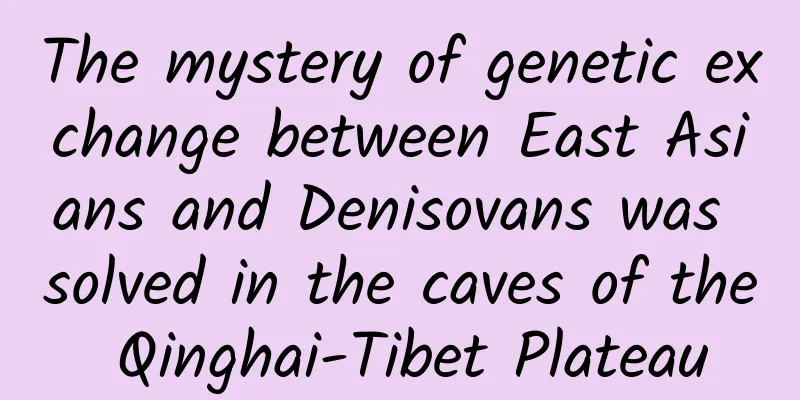The mystery of genetic exchange between East Asians and Denisovans was solved in the caves of the Qinghai-Tibet Plateau

|
Produced by: Science Popularization China Author: Niu Changtai (PhD, Nanjing Institute of Geology and Paleontology, Chinese Academy of Sciences) Producer: China Science Expo Editor's note: In order to decode the latest mysteries of life science, the China Science Popularization Frontier Science Project has launched a series of articles called "New Knowledge of Life" to interpret life phenomena and reveal biological mysteries from a unique perspective. Let us delve into the world of life and explore infinite possibilities. In 2014, a study published in Nature found that the EPAS1 gene mutation that helps Tibetans adapt to the plateau environment is likely inherited from the Denisovans. Since a small number of Han Chinese also have similar mutations, this means that it is likely that the ancestors of East Asian populations, including Tibetans and Han Chinese, had genetic exchanges with the Denisovans and acquired the EPAS1 gene mutation from them. After the ancestors of the Tibetans arrived at the Qinghai-Tibet Plateau, under the natural selection of low oxygen concentrations, the Denisovan-type EPAS1 gene mutation quickly spread among the Tibetans and successfully helped them adapt to the plateau environment. But when and where did the genetic exchange between East Asians and Denisovans occur? Did Denisovans really have the ability to live on the Qinghai-Tibet Plateau? Chinese paleoanthropologists and archaeologists found the answer in the Baishiya Cave on the Qinghai-Tibet Plateau. Magical Baishiya - the former residence of the Denisovans on the Qinghai-Tibet Plateau Located in the north of Xiahe County, Gannan Tibetan Autonomous Prefecture, Gansu Province, Baishiya Karst Cave is the training cave of the Tibetan Buddhist temple Baishiya Temple, which attracts many believers and monks to worship and practice. At the same time, the beautiful scenery here also attracts many tourists. Baishiya Cave entrance (Image source: Reference 9) In 1980, a local lama in Xiahe discovered a human mandibular fossil while practicing in the Baishiya Cave. The fossil passed through the hands of many people and finally came into the hands of Academician Chen Fahu. Xiahe No. 1 fossil, including the right side of a mandible and two molars above it. (Photo courtesy: Professor Zhang Dongju) After obtaining this fossil, Chen Fahu's team was faced with three questions: the first was the location where the fossil was discovered, the second was the age of the fossil, and the third was what species of ancient human the fossil belonged to. Since 2010, Chen Fahu has led the Lanzhou University environmental archaeology team to investigate the entire Xiahe area, trying to find the origin of the fossil. After six years of investigation, they finally found stone tools and animal bone fossils in the Baishiya Cave in 2016, confirming that the cave was once inhabited by prehistoric humans. At the same time, by comparing the surrounding dozen caves, they also determined that Baishiya was the most suitable place for ancient humans to live. However, due to the special nature of the cave, it was not until December 2018 that the Lanzhou University team began to carry out excavation work in the cave. But even though the work was so urgent, in the second year, on May 2, 2019, an international scientific research team led by Academician Chen Fahu and Professor Zhang Dongju published an article on the chronology and paleoproteomics of the Baishiya Karst Cave human fossil in Nature. The study conducted uranium-series dating analysis on the carbonate nodules wrapped around the mandible and found that the fossil was formed 160,000 years ago. Before that, the earliest record of human activities found on the Qinghai-Tibet Plateau was only 40,000 years old. The discovery of this fossil pushed that record forward by 120,000 years. The paleoproteome analysis of the fossil found that its amino acid sequence was closest to the Denisovans in the Denisova Cave in the Altai Mountains, indicating that the ancient human represented by this fossil, the Xiahe people, was likely also a Denisovan. This also proves that the Denisovans had arrived on the Qinghai-Tibet Plateau more than 100,000 years before modern humans arrived and were able to adapt to the thin oxygen environment here. However, since the Xiahe people are only linked to the Denisovans by an amino acid mutation in their proteome and there is a lack of ancient DNA evidence, and the stratum where the Xiahe people's fossils were found has also been unclear, some scholars still have doubts about whether the Xiahe people are Denisovans and whether there was Denisovan activity in the Baishiya Cave. On October 30, 2020, another study published in the journal Science completely dispelled these doubts. The environmental archaeology team of Lanzhou University led by Zhang Dongju cooperated with Fu Qiaomei, a researcher at the Institute of Vertebrate Paleontology and Paleoanthropology of the Chinese Academy of Sciences, to stratify and date the sediments in Baishiya Cave, establish the age framework of Baishiya Cave sediments, and extract ancient DNA from these sediments, discovering mitochondrial DNA of many mammals and ancient humans. Among them, ancient human DNA was produced from sediments dating back about 100,000 years, 60,000 years, and possibly 45,000 years ago. By comparing with ancient human DNA discovered in the past, these ancient human DNAs are most similar to the mitochondrial DNA of the late Denisovans from 80,000 to 50,000 years ago in the Denisova Cave in the Altai Mountains. These findings not only prove that the Denisovans did live in the Baishiya Cave, but also that their living time may have lasted from 160,000 years ago to about 45,000 years ago. So far, we already know that the Denisovans did use the Baishiya Cave as their base and lived on the northeastern edge of the Qinghai-Tibet Plateau for more than 100,000 years. So what resources did they rely on to survive for so long? Life of the Denisovans on the Tibetan Plateau In fact, as early as the excavation work in 2018 and 2019, researchers had discovered thousands of animal bone fossils and tens of thousands of stone tools in the 3-meter-thick cultural sedimentary layer of Baishiya. The sedimentary characteristics also showed that the sediments in the cave had not been disturbed and were accumulated in situ, which means that these animal bones were most likely left by the Denisovans. Preliminary animal archaeological discoveries have shown that these animals include small and medium-sized animals such as antelopes, foxes, and marmots, and large and medium-sized animals such as rhinos, bison, and hyenas. Their bones are very broken, and traces of human chopping and burning can be found on them, proving that the Denisovans once used these animals. On July 3, 2024, Professor Zhang Dongju from the School of Resources and Environment of Lanzhou University and Academician Chen Fahu from the Institute of Tibetan Plateau Research of the Chinese Academy of Sciences jointly led the Paleolithic Environmental Archaeology Team of Lanzhou University and jointly with several foreign research institutions to publish more detailed animal archaeology and paleoproteome research results in the Baishiya Karst Cave in Nature, and discovered new Denisovan fossils. The study conducted animal archaeological research on 2,567 animal bone fossils, including identifying the biological species to which these animal fossils belonged and the traces of human use left on them. Among them, 2005 animal bones were classified and identified, and 1857 bones were analyzed for paleoproteome. More than 20 species of vertebrates were identified from these bone fragments, including large and medium-sized herbivores such as blue sheep, argali, wild yak, red deer, Tibetan antelope, musk deer, wild horse, woolly rhinoceros, carnivores such as spotted hyena, leopard, weasel, stone marten, wolf, Tibetan fox, birds such as pheasant, golden eagle, quail, and small mammals such as plateau rabbit, pika, groove-toothed flying squirrel, marmot, field mouse, porcupine, Gansu zokor, etc. Except for the extinct woolly rhinoceros and the last spotted hyena, most of these animals still live on the Qinghai-Tibet Plateau today. These animals also reflect the living environment of the Denisovans on the Qinghai-Tibet Plateau. Tibetan antelopes, wild yaks and wild horses account for a high proportion of animal bones, indicating that the Gangga Basin where the Baishiya Cave is located is mainly a grassland environment. At the same time, the appearance of red deer, musk deer, groove-toothed flying squirrels and porcupines indicates the existence of a small-scale forest shrub environment. The environment reflected by the animal bone combination is not much different from the environment of the Gangga Basin where the Baishiya Cave is located today, that is, it is mainly grassland, with forest shrubs distributed in hills and river valleys. This is also the environment in which the Denisovans lived for more than 100,000 years. Exterior view of Baishiya Cave. The Denisovans have lived on this grassland for more than 100,000 years. (Image source: Reference 6) Among the 2,005 animal bones, 386 pieces, or 19.3%, showed signs of human processing, including skinning, dismemberment, flesh removal, bone tapping and marrow extraction. Some bones were also used to make simple tools. At the same time, herbivores, carnivores, birds and small mammals all showed signs of being used. This shows that the Denisovans had a wide range of prey and they made full use of and processed the prey they captured. Traces of human use on animal bones found in Baishiya Cave. (Image source: Reference 3) Among thousands of animal bones, the preliminary analysis of the ancient proteome of a rib was different from that of animals around the Qinghai-Tibet Plateau, and morphological studies also showed that this rib was likely to belong to humans. Through more detailed shotgun proteomics analysis, the amino acid sequence of the ancient proteome of this rib was very close to that of the Denisovans, so it can be considered that the ancient humans it represents are Denisovans. This rib was produced from the third layer of sediments, which was deposited about 48,000 to 32,000 years ago, which means that about 40,000 years ago, Denisovans were still living in the Baishiya Cave. Prior to this, the youngest Denisovan fossil No. 3 found in the Denisova Cave in Altai was 76,000-52,000 years old, and the newly discovered Xiahe No. 2 fossil in Baishiya Cave was 40,000 years old, which refreshed the latest survival record of Denisovans. At the same time, this age also overlaps with the age of 45,000-30,000 years old of the earliest modern human site on the Qinghai-Tibet Plateau, the Niadi site. Therefore, judging from the survival time, it is indeed possible for modern humans and Denisovans to meet and have genetic exchanges. This genetic exchange may have ensured that modern humans could reach the summit of the Qinghai-Tibet Plateau 40,000 years ago, and may even have contributed to the EPAS1 gene mutation among Tibetans today. The newly discovered ancient human rib fossil Xiahe 2 (Xiahe 2), ancient proteome analysis shows that it is closely related to the Denisovans. (Image source: Reference 3) Future Outlook Based on the many Denisovan fossils, ancient proteomes and ancient DNA found in sediments found in Baishiya Cave in recent years, we can be sure that the Denisovans did have the ability to live in high altitude areas. At the same time, Denisovan tooth fossils dating back 164,000 to 131,000 years have been discovered in Laos, Southeast Asia, indicating that the Denisovans could also adapt to the humid and hot climate in tropical areas. Molecular anthropology studies based on modern humans also show that they have a genetic influence on modern people in East Asia and Southeast Asia, which means that the geographical range of the Denisovans may be quite wide, and it is unlikely that they are only distributed in the three locations currently discovered. Red dots: Denisovan fossil sites and locations; yellow dots: archaic human fossil sites and related locations; green dots: early modern human fossils and related locations. Serial number: 1. Harbin skull (Dragon Man); 2. Jinniushan site (Jinniushan Man); 3. Xujiayao site (Xujiayao Man); 4. Tianyuandong site (Tianyuandong Man); 5. Shuidonggou Site No. 1 and No. 2; 6. Jiangjunbu site; 7. Yangshang site; 8. Dali Man site (Dali Man); 9. Lingjing site (Xuchang Man); 10. Huanglongdong site (Early Modern Man); 11. Niadi site; 12. Qiusang site; 13. Pilo site; 14. Xinglongdong site; 15. Hualongdong site (Hualongdong Man); 16. Tongzi Yanhuidong site (Tongzi Man); 17. Guanyindong site; 18. Fuyandong site (Early Modern Man); 19. Mabaman site (Mabaman); 20. Penghu Yuanren; 21. Lunadong site (Early Modern Man); 22. Zhirendong site (Early Modern Man). (Image source: Reference 3) Based on a few morphological features, some scholars believe that many ancient human fossils between 300,000 and 100,000 years old in East Asia, including Hualongdong Man, Long Man, Xuchang Man, Xujiayao Man, Dali Man, Jinniushan Man, Penghu Man, Maba Man, etc., may be related to Denisovans. However, since the Denisovan fossils found so far are relatively rare and fragmented, their exact and complete morphological features are still uncertain. At the same time, the above-mentioned East Asian ancient humans lack molecular biological research such as ancient proteomes or ancient DNA, so the morphological and genetic comparison of Denisovans and these ancient humans is still difficult, and the relationship between the two cannot be fully determined. Are there other fossil representatives of the Denisovans in East Asia? What is the relationship between these ancient humans and the Denisovans? I hope that future research can solve these problems, so that the Denisovans will no longer be so mysterious and will be presented to the world in their complete form, so that we can get a glimpse of the style of this prehistoric cousin who made great contributions to modern humans. References: [1] Chen F, Welker F, Shen CC, et al. A late middle Pleistocene Denisovan mandible from the Tibetan Plateau[J]. nature, 2019, 569(7756): 409-412. [2] Zhang D, Xia H, Chen F, et al. Denisovan DNA in late pleistocene sediments from Baishiya Karst Cave on the Tibetan Plateau[J]. Science, 2020, 370(6516): 584-587. [3] Xia H, Zhang D, Wang J, et al. Middle and Late Pleistocene Denisovan subsistence at Baishiya Karst Cave[J]. Nature, 2024, 632(8023): 108-113. [4] Institute of Tibetan Plateau Research, Chinese Academy of Sciences. Nature magazine published the highlights of my research on the discovery of Denisova archaic Homo sapiens on the Qinghai-Tibet Plateau [5] Lanzhou University. Uncovering the story behind the Xiahe Denisovan fossils [6] Institute of Vertebrate Paleontology and Paleoanthropology, Chinese Academy of Sciences. Tracing the Denisovans: Ancient DNA Analysis of Sediments from the Baishiya Cave Site [7] Lanzhou University. [Science Headlines] Denisovan DNA found at Baishiya Karst Cave Site. “Archaeology China” focuses on the major discovery of Lanzhou University’s environmental archaeology team [8] Lanzhou University. The environmental archaeology team of Lanzhou University led the publication of important research results on the Baishiya Karst Cave site in the journal Nature. [9] Institute of Tibetan Plateau Research, Chinese Academy of Sciences. Nature: The Xiahe Denisovans continued to survive on the Tibetan Plateau until about 40,000 years ago |
<<: Want to lose weight but keep getting fatter? Maybe you're not getting enough sleep
Recommend
Expert Interview | Digital rights are the basic rights of the elderly
In order to help the elderly bridge the digital d...
Instead of spewing lava, it spews mud. Is this kind of volcano "not doing its job"?
Question: Volcanoes spew out lava, but what spews...
Liming’s personal profile: The role of plain text external links in website rankings cannot be ignored!
When it comes to making external links, many peop...
Gameplay Analysis | WeChat Reading Sharing System
With the development of e-books, more and more pe...
4 rules for operating advertising accounts!
When interviewing optimizers, I always ask, "...
The mystery of idle smart bracelets and watches: purely recording data does not bring fun
Nowadays, people are increasingly interested in c...
If your organs could talk, how would you be scolded every day?
Review | Li Nannan Director of Hunan Science Writ...
What Zhang Jiayi and Feng Xiaogang are both concerned about is what kind of smart phone is related to family affection?
Nowadays, all walks of life are advocating cross-...
If you are bitten by a five-step snake, is it okay to take four steps?
Ding ding ding ~ Fantastic beasts are coming! Tad...
Brand marketing method, use these 4 steps!
In life, we often see the success of others and t...
Even if you don’t follow stars, you can understand the fan circle in one minute!
This article was first published by Hunzhi (WeCha...
The landing page conversion rate is low, and 90% of the traffic is wasted?
How do you design your landing pages? In bidding,...
Three modes of pair design
[[148849]] Pair programming is an agile software ...
Lao Chen's practical course for beginners to quickly start a Douyin short video account and increase followers, suitable for beginners, quickly increase followers
Lao Chen · Douyin short video novice quick accoun...
What changes will happen in the mobile gaming industry in 2016?
In this maddening industry, there is only one thi...









